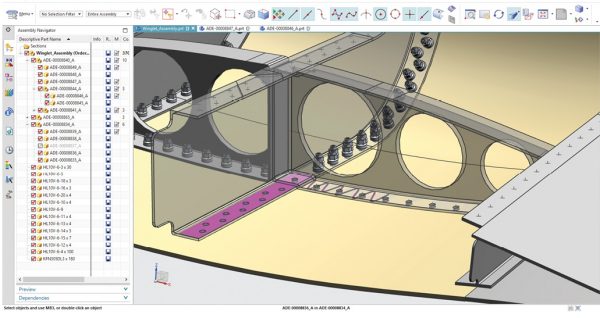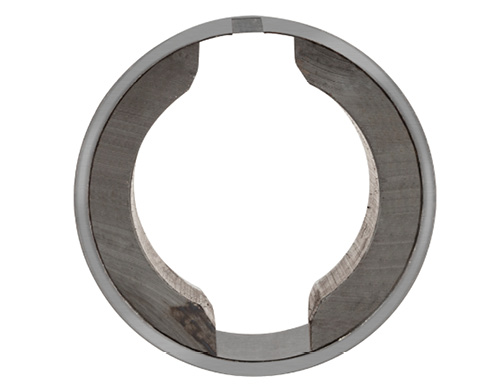
Siemens PLM Software’s Syncrofit allows the ability to specify the areas bonded with adhesives. The information can be transferred to NX CAD and simulation software for further analysis. Images courtesy of Siemens PLM.
Latest News
October 1, 2018
How would you like to drive or ride in a car made of lightweight materials that are glued together? Chances are, you may already be doing so. On Sept. 8, 2014, The Wall Street Journal informed its readers, “Super Glues Are the Secret to Making Cars Lighter.”
 Siemens PLM Software’s Syncrofit allows the ability to specify the areas bonded with adhesives. The information can be transferred to NX CAD and simulation software for further analysis. Images courtesy of Siemens PLM.
Siemens PLM Software’s Syncrofit allows the ability to specify the areas bonded with adhesives. The information can be transferred to NX CAD and simulation software for further analysis. Images courtesy of Siemens PLM.3M, the company best known for its yellow Post-it notes, is a major player in the business of automotive adhesives. In the section of its site dedicated to automotive lightweighting, it writes, “Did you know that some of today’s vehicles contain more than 500 linear feet of adhesive? This is nearly 15 times more adhesive than was used in a vehicle in 2001. There is no question when it comes to lightweight vehicle design, new materials need new methods for joining them together ... Adhesives are playing a larger role in ensuring that engineers can put these materials together without the worry of corrosion, different melting points, or thermal expansion.”
In August, just as the Global Automotive Lightweight Materials Summit was underway (Aug. 21-23 in Detroit), the organizers published an interview with conference speaker Jeff McGarry, engineering group manager, ME Body in White Dispense Technologies, General Motors. McGarry’s team oversees the equipment and processes involved in the application of adhesives and sealers in the body shop.
“One of the biggest challenges with the increased use of adhesives is in process verification,” says McGarry. “Verification of adhesive wet-out within the joint can only be completed by destructive evaluation. Destructive evaluation is costly and time-consuming.”
If this is the case, could digital simulation technologies play a role in verifying the strength and performance of adhesive-bonded joints and structures? We pose the question to some simulation software makers.
Using Multiple Lightweight Materials
Six years ago, manufacturing giant Siemens acquired Vistagy, known for its composite design software Fibersim. With this acquisition, John O’Connor, a Vistagy veteran, became Siemens PLM Software’s director of Aerospace Product and Market Strategy.
“The interest in adhesives came from not only weight reduction but also cost reduction,” he explains. “Mechanically fastened aerospace assemblies are expensive to manufacture. There’s a lot of manual touch labor involved in drilling holes [and] installing fasteners, and the process is injury-prone.” By comparison, “composites are pieces of material essentially glued together.”
“The move to using adhesives is a byproduct of moving to the use of many different materials in a vehicle,” explains Tod Dalrymple, SIMULIA R&D applications director, AM & Materials Applications, Dassault Systèmes. “It is not the adhesives that are directly the driver of the weight savings, but the move to lighter weight materials, which is enabled by the use of adhesives,” adds Shawn Freeman, Structures R&D lead customer projects director, Dassault Systèmes.
The move toward multimaterial vehicles is evident in the current research projects and industry conference talks. In 2015, SAE International published “The Multi Material Lightweight Vehicle Project: PT-170” (sae.org). “The aluminum-intensive structure, combined with carbon fiber, magnesium and titanium, results in full vehicle mass reduction of a C/D class family sedan to that of a subcompact B-car (two vehicle segments lighter),” the authors note.
In 2017, at the Automotive Composites Conference Exhibition (ACCE), Dr. Patrick Blanchard, global technical leader, Composites, Ford Motor Company, delivered a keynote titled “Completing the transition From Metallic to Multi-Material Automotive Solutions.”
One consequence of this trend is the increased use of adhesives. The incorporation of aluminum, magnesium and composites into traditional steel structures forces automakers to rethink how they fasten and join parts. “You would not want to spot-weld steel to aluminum. You cannot spot-weld composites to aluminum,” Dalrymple points out.
Lightweight Materials Glued and Screwed
The adoption of adhesives doesn’t mean the imminent death of traditional fasteners. Screw-less, bolt-less assemblies are becoming more common in smaller consumer electronics, such as smartphones, mobile tablets and connected monitoring devices. But in larger aerospace and automotive projects, fasteners will likely be used in conjunction with adhesives, leading to parts that are both glued and screwed, so to speak.
“Our consensus here is that [adhesives] do not eliminate the need for other fasteners in structural assemblies,” Freeman notes. “It can reduce the number of fasteners, often resulting in a change from spot welds to rivets, or even bolted connections. For non-structural assemblies, the need for spot welds and other fasteners can be significantly reduced and eliminated in some cases.”
One problem associated with traditional fasteners is the potential cracks that develop from cyclical loading and fatigue in the material around holes and bolts. The use of adhesive reduces this risk, but introduces other issues related to scenarios where bonded surfaces may become detached. “If the adhesive joints are not well-protected, you can have debonding. Or an impact to the area of the joint can cause debonding. Also, tight process control in application of the adhesive becomes critical to ensure its strength.” says O’Connor.
Bonded in Pixels
Testing the strength of assembly joints can be done both physically (inside a testing lab) and digitally (inside finite element software programs). Design and simulation software vendors—Dassault Systèmes, Siemens PLM Software and their rivals—have been adding new enhancements to keep up with the evolving practices of the industries they serve.
The key, according to Freeman, is “knowing the proper way to model the connection properties and behaviors—and validating your model.” For simulation software developers, that involves obtaining the proper material characterizations from adhesive suppliers (such as 3M) and material database merchants (such as GRANTA).
In aerospace, Dassault Systèmes is well-known for its flagship CAD products from CATIA and for its 3DEXPERIENCE platform. The company’s SIMULIA brand represents its simulation software portfolio. “We provide technologies and options for discrete fasteners (e.g., spot welds and bolts) and adhesion over large areas (e.g., cohesive contact and cohesive elements),” says Harry Harkness, SIMULIA R&D technology senior director, Dassault Systèmes. “Some situations call for discrete and continuous interface options to be used together.”
Simulation workflow often starts with simple representations, then progresses to detailed digital models of the behaviors of the assemblies. Therefore, one may “start with a simplistic representation of connections, such as permanent bond over entire interface, to get initial perspectives on the system, and then incrementally refine connection details for subsequent investigations,” suggests Harkness.
“For virtual testing, Dassault Systèmes offers a wide range of modeling approaches that already cover spot welds, rivets, bolts, adhesives [and] combinations,” says Laurent Petit, SIMULIA R&D applications manager, Dassault Systèmes. “There are also tools that allow the user to capture various design criteria using the ‘knowledgeware’ toolbox. Plugging these rules to our parametric and topology optimizers could lead to very powerful AI tools that would minimize the weight of an entire vehicle while automatically deciding which technology to use in each local situation.”
Well-defined Joints
Siemens PLM Software, best known for its NX software, design and simulation package, offers Syncrofit, a program for managing complex assemblies and joints. “Syncrofit was developed as a joining tool. It is a design engineer’s solution and operates inside of NX. It also runs inside of Dassault’s CATIA product. The software allows you to specify the method of joining. That includes mechanically fastened joints, welded joints and adhesive-bonded joints. It also lets you incorporate lots of other information about the joints, like the expected loads or finish requirements. That allows you to calculate and predict the behavior of the joints in service over time,” explains O’Connor.
Syncrofit itself doesn’t come with a solver, but the software communicates with Simcenter 3D from Siemens’ Simcenter portfolio. In these products, engineers and designers can simulate and test the various joints and structures in 3D models.
“To simulate the bonded area—the faying surface, as it is called—you specify the characteristics of the adhesive involved, such as thickness and coverage. That information can be communicated to Simcenter 3D,” says O’Connor. “Adhesives usually don’t behave in a linear fashion, like steel or metal, so you need more sophisticated simulation methods, like those available in Simcenter 3D.”
“We now have the capability to define adhesively bonded joints to simulate and predict how they perform in service. But the technology is evolving. You have lots of new adhesives developed for different types of applications. The ability to get the right properties to run the simulation in CAE tools is critical, so we work with material vendors to help our customers gather those properties,” adds O’Connor.
See Where it Sticks
The composite-related weight reduction statistics from 3M are quite tantalizing. The adhesive maker reveals, “Components made of carbon-fiber reinforced plastic (CFRP) are up to 40% lighter than steel components, while aluminum is around 20% lighter. Modern and highly filled thermoplastics reduce weight by up to 30%.”
Freeman notices the pervasiveness of adhesives use now, compared to 20 years ago. “There have always been low volume uses of non-traditional materials among the original equipment manufacturers, but now we see a lot more flexibility in material selection even for the large volume vehicles,” he says.
 The 3M Magnet Bonding Adhesive AU-205 is one example of how design engineers are using adhesives. It is designed to provide electric motor design and manufacturing engineers with a means to bond permanent magnets to rotors and stators in high-efficiency permanent magnet electric motors. Image courtesy of 3M via Business Wire.
The 3M Magnet Bonding Adhesive AU-205 is one example of how design engineers are using adhesives. It is designed to provide electric motor design and manufacturing engineers with a means to bond permanent magnets to rotors and stators in high-efficiency permanent magnet electric motors. Image courtesy of 3M via Business Wire.But it would be a mistake to get too aggressive with adhesives to bond lightweight materials. In products that are designed to be disposable with a limited lifespan (for example, smartwatches), it may not matter. In aerospace and automotive projects, where the aircraft and vehicles are expected to go through numerous repair and maintenance cycles throughout their long lifespans, the inseparable bonds could prove costly, if used unwisely.
“When an assembly needs to be repaired, it’s one thing to remove the bolts and fasteners to disassemble it, but quite another to debond a glued part,” O’Connor points out. “While there are lots of advantages to adhesive-bonded parts, there are also questions about where it’s appropriate to use them, and where it’s not. Understanding this balance is important for best utilizing the ongoing innovations in adhesive technologies.”
For More Info
Global Automotive Lightweight Materials Summit
Subscribe to our FREE magazine, FREE email newsletters or both!
Latest News
About the Author
Kenneth Wong is Digital Engineering’s resident blogger and senior editor. Email him at [email protected] or share your thoughts on this article at digitaleng.news/facebook.
Follow DE





